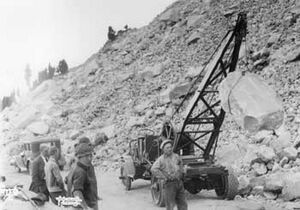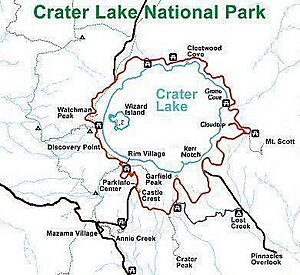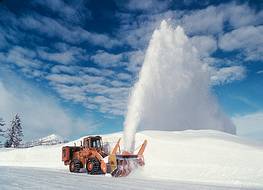Rim Drive facts for kids
Quick facts for kids |
|
|
Rim Drive Historic District
|
|
| Location | Crater Lake National Park |
|---|---|
| Nearest city | Klamath Falls, Oregon, USA |
| Built | 1926-1941 |
| Architect | John Sargent, Francis Lange, et al. |
| NRHP reference No. | 08000041 |
| Added to NRHP | 2008 |
Rim Drive is a beautiful road in Crater Lake National Park in southern Oregon, United States. It is a 33-mile (53 km) loop that goes all the way around the edge of Crater Lake. This road is special because of how it was built and how it fits into the amazing park landscape. Because of this, Rim Drive was added to the National Register of Historic Places in 2008. This means it is a very important historic place in the United States.
Contents
History of Rim Drive
Crater Lake sits inside a huge bowl called a caldera. This caldera formed about 7,700 years ago. A very tall mountain, Mount Mazama, which was about 12,000 feet (3,658 m) high, collapsed after a giant volcanic eruption. Over thousands of years, rain filled this bowl, creating the beautiful lake we see today.
Early Efforts to Protect Crater Lake
In 1886, a man named William Gladstone Steel joined a group from the United States Geological Survey. They were exploring Crater Lake. During this trip, Steel named many famous spots around the lake. These included Wizard Island, Llao Rock, and Skell Head. Steel was so amazed by the lake's beauty. When he returned, he started working hard to make Crater Lake a national park.
On May 22, 1902, President Theodore Roosevelt signed a bill. This bill made Crater Lake the sixth national park in the country. The United States Department of the Interior was then in charge of building roads and services for visitors. This was a tough job because the park was far away, high up in the Cascade Mountains. By 1905, a "steep and winding" road to the lake's rim was finished. This first road was very important for the park's future.
Building the First Rim Road
In 1913, the government gave money to the United States Army Corps of Engineers. Their job was to build a road around Crater Lake. They chose Munson Valley, about three miles (5 km) south of the rim, as the best spot for their building headquarters. This area was central and had wood for building. However, World War I slowed down the road construction.
The road around the lake was finally completed in 1919. In July of that year, the National Park Service took over. They were now responsible for keeping up the new loop road, which was called Rim Road. This first road was only 12 feet (3.7 m) wide. Some parts were very steep, with slopes as much as ten percent. Because of these problems, a big upgrade was needed soon after the original road was finished.
How Rim Drive Was Built
The Rim Drive you see today is a 33-mile (53 km) loop. It was built by the Bureau of Public Roads and the National Park Service. The Civilian Conservation Corps also helped a lot. The new road was planned to be 18 feet (5.5 m) wide. It also had 3-foot (0.9 m) wide shoulders on the sides.
Construction Process
Workers mapped out and leveled the new road in 1931 and 1932. The base of the road was built over the next two years. In 1935, the first layer of paving was put down. Any parts of the old road that were not used were dug up. The land was then returned to its natural state. Lane lines were painted on the road in 1938.
Work on the road's drainage, stone guardrails, and viewing spots continued until 1941. Building this road was a huge engineering success. It was completed for two million dollars, even with the difficult mountains.
Blending with Nature
One main goal for Rim Drive was to make it look like a natural part of the environment. They did a great job! The road has gentle curves and no sharp turns, even though the land is very rugged. Rustic stone guardrails were built along curves and at most of the viewpoints. These guardrails look like they are part of the landscape.
The viewpoints offer amazing views of the lake. But the road itself cannot be seen from most of these spots. Rim Drive was added to the National Register of Historic Places in 2008. This was because of its unique history, how it was built, its stone work, the hiking trails, and the views of Crater Lake. The American Automobile Association has even called Rim Drive one of the "ten most beautiful roads in the United States."
Exploring the Rim Drive Route
Rim Drive is located high up in the Cascade Mountains. Its lowest point is about 6,500 feet (1,981 m) above sea level. The road reaches almost 7,900 feet (2,408 m) at its highest point on top of Cloudcap. Rim Drive has eight main viewing areas where you can park your car.
Main Viewing Areas
Four of these viewing spots are right off the road. These include Pumice Point, Skell Head, Cloudcap, and Kerr Notch. Short trails from parking areas lead to the other four viewing spots. These are Sinnott Memorial, Discovery Point, Watchman Lookout, and Merriam Point. Besides these main areas, there are 15 smaller pull-off spots along the road for quick views.
West Rim Drive
If you start heading northwest from the Crater Lake National Park headquarters, it's three miles (5 km) to the lake rim. Here you will find the Rim Village visitor area. The Sinnott Memorial overlook is located in Rim Village.
Leaving Rim Village, the speed limit is 35 miles per hour (56 km/h). You will reach the Discovery Point viewing area in just over one mile (1.6 km). From there, it's five miles (8 km) to the North Entrance Road junction. Along this part, you will cross the 7,350-foot (2,240 m) West Rim Summit. This section of Rim Drive is called West Rim Drive. Many visitors use this part of the road in summer. It connects the park's north and south entrances. It also passes by Rim Village and the park headquarters. This part of the road offers classic views of Crater Lake and Wizard Island.
East Rim Drive
Continuing north on Rim Drive past the North Entrance Road junction, you will drive along the back side of Llao Rock. This is the start of East Rim Drive. The next place to view the lake is about two miles (3.2 km) past the North Entrance Road junction. Viewpoints along East Rim Drive are usually not as busy. The exception is the Cleetwood Cove parking area. This is at the north end of Crater Lake. Cleetwood Cove is where the only hiking trail down into the crater begins. The National Park Service also has a marina here for boat tours.
Beyond Cleetwood Cove, on East Rim Drive, there are seven more pull-off viewing spots. These spots still have most of their original stone work. They offer great views of Crater Lake. The first of these is above Grotto Cove, about halfway around the lake from Rim Village. The next spot is Skell Head, about half a mile (0.8 km) from Grotto Cove. The next five viewing spots are spread out over about seven miles (11.3 km). These stops are Cloudcap, Cottage Rocks, Sentinel Point, Reflection Point, and Kerr Notch. Each spot has views of the lake and the surrounding landscape, including Mount Scott.
Kerr Notch is 21 miles (34 km) from Rim Village. It is the last viewpoint on the Rim Drive loop with a view of the lake. After Kerr Notch, the road goes across the east side of Dutton Ridge. Here you can see the Klamath Basin from near the East Rim Summit. Rim Drive then goes down to the Sun Notch trailhead. From here, visitors can hike to another viewpoint overlooking the lake. Rim Drive continues along the edge of Sun Meadow. It leads to a parking area in front of Vidae Falls, a 100-foot (30 m) waterfall. Vidae Falls has a picnic area and a trail to a small volcano called Crater Peak.
The last two miles (3 km) of Rim Drive pass by the Castle Crest Wildflower Garden. The half-mile (0.8 km) long Castle Crest Nature Trail takes visitors through a wetland full of wildflowers. The best time to see the wildflowers is in July and August. Rim Drive ends half a mile (0.8 km) from the Castle Crest parking area. It connects with the Munson Valley Road junction, near the park headquarters and visitor center.
How to Get to Rim Drive
Rim Drive has two main ways to get onto it. The south entrance starts at the park headquarters in the Munson Valley Historic District. This is about sixty miles (97 km) north of Klamath Falls, Oregon. The road to Munson Valley is open all year. However, there is a lot of snow in the park during winter. Winter storms can make driving in the Crater Lake area tricky.
The park's north entrance is nine miles (14 km) north of the Rim Drive junction. This area is known as the Pumice Desert. From the north entrance, it is 119 miles (192 km) to Bend, Oregon. The North Entrance Road closes in the fall and does not open again until the next summer.
In the Crater Lake area, winter lasts about eight months. On average, there are 533 inches (1,354 cm) of snow each year. Many snow banks stay well into the summer. The park headquarters and visitor center at Munson Valley are open all year. The Rim Village cafeteria is also open year-round. But Rim Drive itself is only open during the summer. This is because of the very heavy snowfall. In most places, the road is covered by more than 20 feet (6 m) of snow. Some snow drifts can be as deep as 60 feet (18 m)! Special sensors buried in the road help snow removal crews find the center of the road under all that snow.
During the summer, the National Park Service charges a $30 fee for private cars entering the park. In non-summer months, the fee is $15 for private cars. Larger commercial vehicles are charged between $25 and $200, depending on how many people they can carry.






